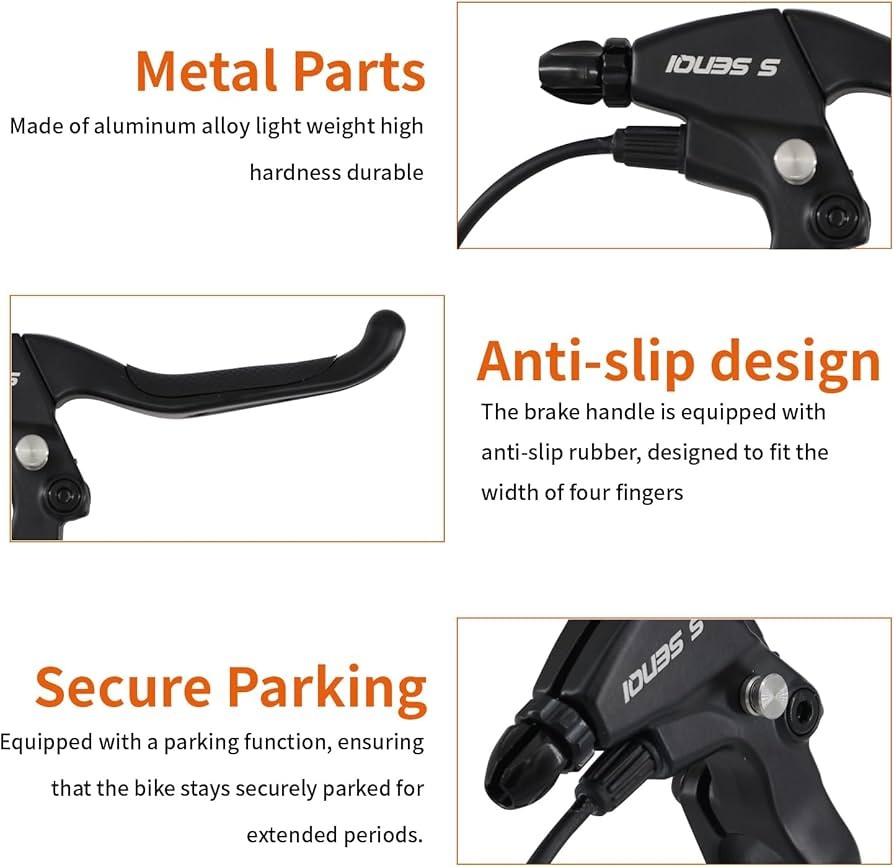Braking is one of the most critical aspects of an e-bike’s performance. Whether you’re cruising through city streets or tackling steep downhill trails, high-performance e-bike brakes ensure a safe and smooth ride. Without reliable brakes, you risk accidents, reduced control, and excessive wear on other components.
This guide will help you understand different braking systems, how to choose the best E-bike brake lever upgrade, and how to maintain and adjust your brakes for smooth braking for e-bikes. If you’re looking for top-rated e-bike brake systems, this article will provide all the insights you need.
Understanding E-Bike Brake Systems
To make informed decisions about upgrading or maintaining your e-bike brakes, it’s essential to understand the key components of an electric bike brake system.

1. Mechanical Brake vs.Hydraulic Brake
One of the biggest differences in high-performance electric bike brakes is whether they use hydraulic or mechanical brake levers:
- Hydraulic E-Bike Brake Levers: These use fluid to transfer force from the lever to the brake calipers. They provide smoother and more powerful braking with less effort but require more maintenance.
- Mechanical E-Bike Brake Levers: These use a cable system to engage the brakes. They are easier to maintain and adjust but may require more effort to achieve the same braking power as hydraulic systems.
2. Disc Brakes vs. Rim Brakes
Most modern e-bikes use disc brakes because they offer superior stopping power and performance in all weather conditions. However, some budget-friendly models may still use rim brakes, which are lighter but less effective in wet conditions.
3. Brake Responsiveness for Electric Bikes
A well-tuned braking system should provide instant response without being overly sensitive. Factors that affect brake responsiveness include:
- Brake pad material
- Rotor size (larger rotors provide better stopping power)
- Brake lever tension and positioning
Now that you understand the basics, let’s explore how to choose the right brake levers for your e-bike.
Choosing the Right Brake Levers
Upgrading your brake levers is one of the best ways to enhance your e-bike’s braking efficiency. Here’s what to consider when selecting adjustable e-bike brake levers or the best disc brake levers for e-bikes.

1. Adjustable E-Bike Brake Levers
Adjustability allows you to customize lever positioning based on your hand size and riding style. Brake lever positioning for safety ensures you can easily reach and engage the brakes without straining your fingers.
2. Lightweight Brake Levers for E-Bikes
Lighter brake levers reduce overall bike weight, improving handling. If you’re an urban commuter, weight savings can enhance your riding experience.
3. Brake Lever Compatibility with Disc Brakes
Before upgrading, ensure your new levers are compatible with your braking system. Hydraulic and mechanical brake levers require different designs, and some models are only suitable for specific types of disc brakes.
How to Upgrade Your E-Bike Brakes
If you want better braking performance, consider an e-bike brake lever upgrade. Here’s a step-by-step guide to replacing your brake levers.
Step 1: Gather Your Tools
- New high-performance e-bike brake levers
- Allen wrenches
- Cable cutters (for mechanical brakes)
- Hydraulic brake fluid (for hydraulic brakes)
Step 2: Remove Old Brake Levers
- Loosen the bolt securing the lever to the handlebar.
- If you have mechanical brakes, disconnect the brake cable.
- If you have hydraulic brakes, detach the hydraulic line (be careful of fluid leakage).
Step 3: Install the New Brake Levers
- Attach the new brake levers to the handlebar and tighten the bolts.
- For mechanical levers, thread the brake cable through and adjust the tension.
- For hydraulic levers, reconnect the hydraulic line and bleed the brakes to remove air bubbles.
Step 4: Adjust Brake Lever Positioning
Ensure your brake lever positioning for safety is comfortable. Your fingers should easily reach the levers without stretching.
Maintaining and Adjusting Your Brakes

Once you have installed your best disc brake levers for e-bikes, regular maintenance is essential to keep them working at peak performance. Here’s how:
1. Cleaning and Inspecting Your Brakes
- Wipe down brake rotors and pads with isopropyl alcohol to remove dirt.
- Inspect brake pads for wear and replace them if they are less than 1mm thick.
2. E-Bike Brake Lever Adjustment
If your brakes feel too loose or too tight, follow these steps:
- For mechanical brakes, adjust the cable tension by turning the barrel adjuster.
- For hydraulic brakes, bleed the system if the lever feels spongy.
3. Fixing Common Brake Problems
- Squeaky Brakes: Clean the rotor and brake pads.
- Weak Braking Power: Check if the pads make full contact with the rotor and adjust tension if necessary.
- Brake Fade: If your brakes lose power over time, your pads may be overheating. Consider using heat-resistant brake pads.
Why Upgrading to High-Performance Brakes Matters
Investing in top-rated e-bike brake systems significantly improves safety and ride quality. Here are some final takeaways:
- Better stopping power: Essential for high-speed e-bikes.
- Smoother braking for e-bikes: Reduces hand fatigue and improves ride comfort.
- Longer lifespan: High-quality brake components last longer, reducing maintenance costs.
- Improved customization: Adjustable levers allow riders to fine-tune their setup.
By understanding how to replace e-bike brake levers, choosing the right components, and keeping up with maintenance, you’ll ensure your e-bike delivers a safe and enjoyable riding experience for years to come.
Conclusion
Your e-bike’s braking system plays a crucial role in safety and performance. Whether you’re upgrading to high-performance e-bike brakes, switching to hydraulic e-bike brake levers, or fine-tuning your e-bike brake lever adjustment, these changes can make a big difference.
By following this guide, you’ll be able to confidently select, install, and maintain the best disc brake levers for e-bikes, ensuring smooth braking for e-bikes on every ride. Happy and safe riding! 🚲








